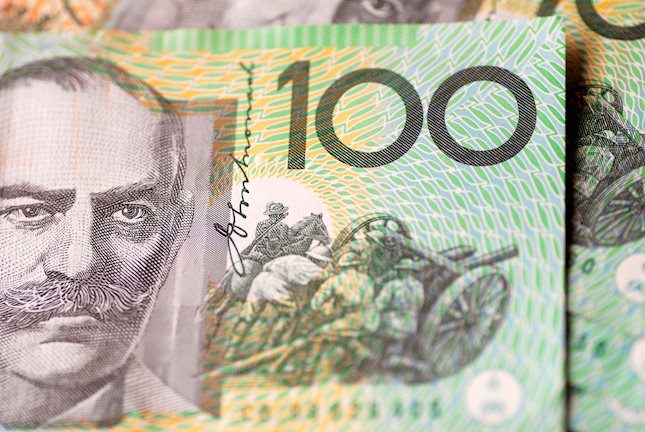- AUD/USD slumps to near 0.6170 as the US Dollar performs strongly on stubborn US inflation outlook.
- Investors await the US NFP data for fresh guidance on interest rates.
- The Australian Dollar weakens on moderate growth in Australian Retail Sales and China’s inflation.
The AUD/USD pair posts a fresh two-year low near 0.6170 in Thursday’s European session. The Aussie pair performs weakly as the US Dollar (USD) strengthens after reports from CNN showed that United States (US) President-elect Donald Trump plans to declare a national economic emergency. Market participants see the move as a major step by Trump towards constructing a new tariff program through legal justification to make “America great again”.
US Dollar PRICE Today
The table below shows the percentage change of US Dollar (USD) against listed major currencies today. US Dollar was the strongest against the British Pound.
| USD | EUR | GBP | JPY | CAD | AUD | NZD | CHF | |
|---|---|---|---|---|---|---|---|---|
| USD | 0.09% | 0.60% | -0.24% | 0.00% | 0.29% | 0.25% | 0.05% | |
| EUR | -0.09% | 0.49% | -0.33% | -0.08% | 0.20% | 0.16% | -0.06% | |
| GBP | -0.60% | -0.49% | -0.83% | -0.59% | -0.32% | -0.34% | -0.54% | |
| JPY | 0.24% | 0.33% | 0.83% | 0.23% | 0.52% | 0.43% | 0.28% | |
| CAD | -0.01% | 0.08% | 0.59% | -0.23% | 0.29% | 0.24% | 0.05% | |
| AUD | -0.29% | -0.20% | 0.32% | -0.52% | -0.29% | -0.04% | -0.24% | |
| NZD | -0.25% | -0.16% | 0.34% | -0.43% | -0.24% | 0.04% | -0.19% | |
| CHF | -0.05% | 0.06% | 0.54% | -0.28% | -0.05% | 0.24% | 0.19% |
The heat map shows percentage changes of major currencies against each other. The base currency is picked from the left column, while the quote currency is picked from the top row. For example, if you pick the US Dollar from the left column and move along the horizontal line to the Japanese Yen, the percentage change displayed in the box will represent USD (base)/JPY (quote).
Investors expect that Trump’s protectionist policies will be pro-growth and inflationary for the US. This scenario is USD-positive as it typically forces Federal Reserve (Fed) policymakers to adopt a hawkish monetary policy stance.
Meanwhile, the Federal Open Market Committee (FOMC) minutes of the December meeting in which the Fed cut interest rates by 25 basis points (bps) to the range of 4.25%-4.50% have already shown that officials are worried about growing risks to a slowdown in the US inflation progress towards the central bank’s target of 2% due to potential trade and immigration policy changes.
Going forward, investors will focus on the US Nonfarm Payrolls (NFP) data for December, which will be published on Friday. The US official employment data will influence market expectations for the Fed’s likely interest rate action in the policy meeting later this month.
The Australian Dollar (AUD) underperforms its major peers on Thursday amid weaker-than-expected growth in the Australian Retail Sales data for November. Aussie Retail Sales grew by 0.8%, slower than estimates of 1% but faster than the former reading of 0.5%. Slower-than-expected Retail Sales growth is expected to boost Reserve Bank of Australia's (RBA) dovish bets. Traders have fully priced in a 25-bps interest rate reduction from the RBA in the policy meeting in April.
Apart from that, an expected slowdown in the China Consumer Price Index (CPI) data for December has also weighed on the AUD. The Aussie currency faces pressure being a proxy to China’s economy. China’s annual CPI rose by 0.1%, as expected, slower than the former reading of 0.2%.
Australian Dollar FAQs
One of the most significant factors for the Australian Dollar (AUD) is the level of interest rates set by the Reserve Bank of Australia (RBA). Because Australia is a resource-rich country another key driver is the price of its biggest export, Iron Ore. The health of the Chinese economy, its largest trading partner, is a factor, as well as inflation in Australia, its growth rate and Trade Balance. Market sentiment – whether investors are taking on more risky assets (risk-on) or seeking safe-havens (risk-off) – is also a factor, with risk-on positive for AUD.
The Reserve Bank of Australia (RBA) influences the Australian Dollar (AUD) by setting the level of interest rates that Australian banks can lend to each other. This influences the level of interest rates in the economy as a whole. The main goal of the RBA is to maintain a stable inflation rate of 2-3% by adjusting interest rates up or down. Relatively high interest rates compared to other major central banks support the AUD, and the opposite for relatively low. The RBA can also use quantitative easing and tightening to influence credit conditions, with the former AUD-negative and the latter AUD-positive.
China is Australia’s largest trading partner so the health of the Chinese economy is a major influence on the value of the Australian Dollar (AUD). When the Chinese economy is doing well it purchases more raw materials, goods and services from Australia, lifting demand for the AUD, and pushing up its value. The opposite is the case when the Chinese economy is not growing as fast as expected. Positive or negative surprises in Chinese growth data, therefore, often have a direct impact on the Australian Dollar and its pairs.
Iron Ore is Australia’s largest export, accounting for $118 billion a year according to data from 2021, with China as its primary destination. The price of Iron Ore, therefore, can be a driver of the Australian Dollar. Generally, if the price of Iron Ore rises, AUD also goes up, as aggregate demand for the currency increases. The opposite is the case if the price of Iron Ore falls. Higher Iron Ore prices also tend to result in a greater likelihood of a positive Trade Balance for Australia, which is also positive of the AUD.
The Trade Balance, which is the difference between what a country earns from its exports versus what it pays for its imports, is another factor that can influence the value of the Australian Dollar. If Australia produces highly sought after exports, then its currency will gain in value purely from the surplus demand created from foreign buyers seeking to purchase its exports versus what it spends to purchase imports. Therefore, a positive net Trade Balance strengthens the AUD, with the opposite effect if the Trade Balance is negative.
Information on these pages contains forward-looking statements that involve risks and uncertainties. Markets and instruments profiled on this page are for informational purposes only and should not in any way come across as a recommendation to buy or sell in these assets. You should do your own thorough research before making any investment decisions. FXStreet does not in any way guarantee that this information is free from mistakes, errors, or material misstatements. It also does not guarantee that this information is of a timely nature. Investing in Open Markets involves a great deal of risk, including the loss of all or a portion of your investment, as well as emotional distress. All risks, losses and costs associated with investing, including total loss of principal, are your responsibility. The views and opinions expressed in this article are those of the authors and do not necessarily reflect the official policy or position of FXStreet nor its advertisers. The author will not be held responsible for information that is found at the end of links posted on this page.
If not otherwise explicitly mentioned in the body of the article, at the time of writing, the author has no position in any stock mentioned in this article and no business relationship with any company mentioned. The author has not received compensation for writing this article, other than from FXStreet.
FXStreet and the author do not provide personalized recommendations. The author makes no representations as to the accuracy, completeness, or suitability of this information. FXStreet and the author will not be liable for any errors, omissions or any losses, injuries or damages arising from this information and its display or use. Errors and omissions excepted.
The author and FXStreet are not registered investment advisors and nothing in this article is intended to be investment advice.
Recommended content
Editors’ Picks

AUD/USD side-lines near 0.6200 as traders await US NFP report
AUD/USD consolidates near 0.6200 early Friday, just above its lowest level since October 2022 as traders move to the sidelines ahead of Friday's closely-watched US NFP data releae. Meanwhile, rising bets for an early RBA rate cut, China's economic woes and US-Sino trade war fears act as a headwind for the Aussie.

USD/JPY bulls take a breather above 158.00 ahead of US NFP
USD/JPY takes a breather above 158.00 following the release of household spending data from Japan, slightly off the multi-month top amid wavering BoJ rate hike expectations. However, the widening of the US-Japan yield differential keeps the pair supported amid a bullish US Dollar. US NFP data awaited.

Gold needs a US NFP miss to sustain the upside
Gold price consolidates the weekly gains just below the one-month high of $2,678 set on Thursday as traders eagerly await the US Nonfarm Payrolls data for placing fresh bets.

Nonfarm Payrolls forecast: US December job gains set to decline sharply from November
US Nonfarm Payrolls are expected to rise by 160K in December after jumping by 227K in November. US jobs data is set to rock the US Dollar after hawkish Fed Minutes published on Wednesday.

How to trade NFP, one of the most volatile events Premium
NFP is the acronym for Nonfarm Payrolls, arguably the most important economic data release in the world. The indicator, which provides a comprehensive snapshot of the health of the US labor market, is typically published on the first Friday of each month.

Best Forex Brokers with Low Spreads
VERIFIED Low spreads are crucial for reducing trading costs. Explore top Forex brokers offering competitive spreads and high leverage. Compare options for EUR/USD, GBP/USD, USD/JPY, and Gold.